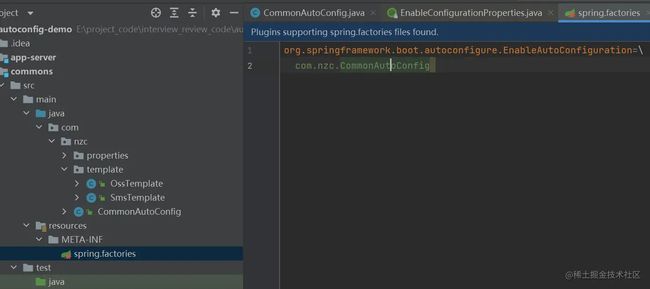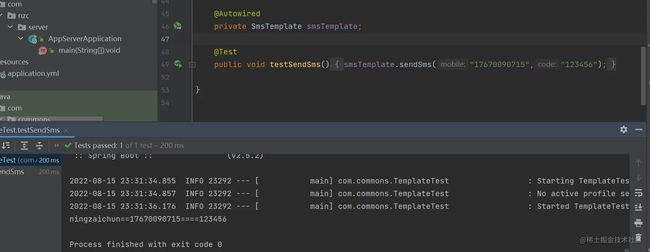前言
实现starter,其实就是SpringBoot的自动装配原理的一个实践,以前我也写过SpringBoot的自动状态原理的文章,文章链接
细心认真对待,没有什么是很难的。
一、SpringBoot 中的SPI机制
什么是spi呢,全称是Service Provider Interface。简单翻译的话,就是服务提供者接口,是一种寻找服务实现的机制。
其实就是一个规范定义、或者说是实现的标准。
用生活中的例子说就是,你买了一台小米的手机。
但是你用的充电器并不一定非要是小米充电器,你可以拿其他厂商的充电器来进行充电,只要满足协议、端口等要求,那么就是可以充电的。这也是一种热拔插的思想,并不是固定死的。
换成代码来说也是一样的,我定义了一个接口,但是不想固定死具体的实现类,因为那样如果要更换实现类就要改动源代码,这往往是不合适的。
那么我也可以定义一个规范,在之后需要更换实现类或增加其他实现类时,遵守这个规范,我也可以动态的去发现这些实现类。
换在SpringBoot中,就是现在的SpringBoot这个平台定义了一些规范和标准,我现在想要让SpringBoot平台接纳我。
我该如何做呢?
很简单,按照它的标准和规范做事。
SpringBoot在启动的时候,会扫描所有jar包resource/META-INF/spring.factories文件,依据类的全限定名,利用反射机制将Bean装载进容器中。
看完这段话,我想你应该对今天的文章应该有个大概的理解啦。
二、自定义 starter
说一说我的小实践:
在这个 starter 中,实现
- 发送短线的Template
- 对象存储的Template
的自动装配~
大致就是四步:
- 用于映射配置文件中的配置的类xxxxProperties
- 用于操作xxxx的接口和客户端等等,如本文中的OssTemplate
- 自动配置类xxxxAutoConfiguration ,并且向容器中注入xxxxTemplate
- 在spring.factories中将xxxxAutoConfiguration添加进EnableAutoConfiguration的vaule集合中
对象存储我用的是阿里云的oss,里面的配置都是可以用的, 短信的话,就是个模拟的啦~,勿怪啦
2.1、准备一个Maven项目
删除src目录,
然后再创建两个 Maven项目(我个人习惯,习惯创建空Maven项目,实际上创建SpringBoot项目也是一样)
最外层的pom.xml
org.springframework.boot spring-boot-starter-parent 2.5.2 8 8 org.projectlombok lombok org.springframework.boot spring-boot-starter-web org.springframework.boot spring-boot-starter org.springframework.boot spring-boot-starter-test org.springframework.boot spring-boot-configuration-processor true
2.2、准备Properties类
就是用来映射配置文件的~
/**
* @author Ning Zaichun
*/
@Data
@ConfigurationProperties(prefix = "nzc.oss")
public class OssProperties {
private String accessKey;
private String secret;
private String bucketName;
private String url;
private String endpoint;
}
@Data
@ConfigurationProperties(prefix = "nzc.sms")
public class SmsProperties {
private String name;
}
2.3、准备要注入的类
就是我们最后要通过自动装配注入进SpringBoot操作的类
我这里分别是OssTemplate 和 SmsTemplate
/**
* @author Ning Zaichun
*/
public class OssTemplate {
private OssProperties ossProperties;
public OssTemplate(OssProperties ossProperties) {
this.ossProperties = ossProperties;
}
public String test() {
System.out.println(ossProperties.getBucketName());
return "test";
}
public String upload(String filename, InputStream is) {
// yourEndpoint填写Bucket所在地域对应的Endpoint。以华东1(杭州)为例,Endpoint填写为https://oss-cn-hangzhou.aliyuncs.com。
String endpoint = ossProperties.getEndpoint();
// 阿里云主账号AccessKey拥有所有API的访问权限,风险很高。强烈建议您创建并使用RAM账号进行API访问或日常运维,请登录 https://ram.console.aliyun.com 创建RAM账号。
String accessKeyId = ossProperties.getAccessKey();
String accessKeySecret = ossProperties.getSecret();
// 创建OSSClient实例。
OSS ossClient = new OSSClientBuilder().build(endpoint, accessKeyId, accessKeySecret);
String storePath = new SimpleDateFormat("yyyy/MM/dd").format(new Date()) + "/" + UUID.randomUUID() + filename.substring(filename.lastIndexOf("."));
System.out.println(storePath);
// 依次填写Bucket名称(例如examplebucket)和Object完整路径(例如exampledir/exampleobject.txt)。Object完整路径中不能包含Bucket名称。
ossClient.putObject(ossProperties.getBucketName(), storePath, is);
String url = ossProperties.getUrl() + storePath;
// 关闭OSSClient。
ossClient.shutdown();
return url + "#" + storePath;
}
public void remove(String fileUrl) {
// yourEndpoint填写Bucket所在地域对应的Endpoint。以华东1(杭州)为例,Endpoint填写为https://oss-cn-hangzhou.aliyuncs.com。
String endpoint = ossProperties.getEndpoint();
// 阿里云账号AccessKey拥有所有API的访问权限,风险很高。强烈建议您创建并使用RAM用户进行API访问或日常运维,请登录RAM控制台创建RAM用户。
String accessKeyId = ossProperties.getAccessKey();
String accessKeySecret = ossProperties.getSecret();
// 填写Bucket名称。
String bucketName = ossProperties.getBucketName();
// 填写文件完整路径。文件完整路径中不能包含Bucket名称。
//2022/01/21/f0870eb3-4714-4fae-9fc3-35e72202f193.jpg
String objectName = fileUrl;
// 创建OSSClient实例。
OSS ossClient = new OSSClientBuilder().build(endpoint, accessKeyId, accessKeySecret);
// 删除文件或目录。如果要删除目录,目录必须为空。
ossClient.deleteObject(bucketName, objectName);
// 关闭OSSClient。
ossClient.shutdown();
}
}
public class SmsTemplate {
private SmsProperties properties;
public SmsTemplate(SmsProperties properties) {
this.properties = properties;
}
public void sendSms(String mobile, String code){
System.out.println(properties.getName()+"=="+mobile+"===="+code);
}
}
2.4、AutoConfiguration
@EnableConfigurationProperties({
SmsProperties.class,
OssProperties.class
})
public class CommonAutoConfig {
@Bean
public SmsTemplate smsTemplate(SmsProperties smsProperties){
return new SmsTemplate(smsProperties);
}
@Bean
public OssTemplate ossTemplate(OssProperties ossProperties){
return new OssTemplate(ossProperties);
}
}
2.5、编写spring.factories
在resource目录下,创建一个META-INF文件夹,
在META-INF文件夹下创建一个spring.factories文件
内容是
org.springframework.boot.autoconfigure.EnableAutoConfiguration=\ com.nzc.CommonAutoConfig
如果有多个就是:
org.springframework.boot.autoconfigure.EnableAutoConfiguration=\ com.nzc.CommonAutoConfig \ com.xxx.xxx
到这一步之后,我们将这个项目,达成Jar包,然后在要使用的项目中进行引入。
2.6、应用测试
- 1、创建一个SpringBoot 的启动类,有启动类才能进行测试,不然没上下文环境~
- 2、编写配置文件
spring: application: name: app-server nzc: sms: name: ningzaichun oss: accessKey: xxx secret: xxx endpoint: oss-cn-shenzhen.aliyuncs.com bucketName: xxx url: xxx
将oss的配置修改正确是可以用的~
编写测试类:
@RunWith(SpringRunner.class)
@SpringBootTest(classes = AppServerApplication.class)
public class TemplateTest {
@Autowired
private OssTemplate ossTemplate;
@Test
public void testOss(){
String s = ossTemplate.test();
System.out.println(s);
}
@Test
public void testUpload(){
try {
File file = new File("D:\evectionflow01.png");
InputStream inputStream = new FileInputStream(file);
ossTemplate.upload("123.jpg",inputStream);
} catch (FileNotFoundException e) {
e.printStackTrace();
}
}
@Autowired
private SmsTemplate smsTemplate;
@Test
public void testSendSms(){
smsTemplate.sendSms("17670090715","123456");
}
}
证明是可以使用的~
后记
写得较为简单,也通俗易懂~,应该能明白吧,哈哈,
如果文中有存在错误或者是不对的地方,请留下您的评论,我会及时修正,非常感谢!
这次可能是说点废话,以前我觉得工作三四年的Java开发工作者,应该是会懂很多很多东西。
因为是后端开发吗,很多时候不可避免的要接触到一些其他东西,
运维部署、测试、前端、底层、架构什么的,我说的是接触,而不是精通~,不要骂我。只是个人看法。
到此这篇关于SpringBoot SPI 机制和实现自定义 starter的文章就介绍到这了,更多相关SpringBoot SPI内容请搜索脚本之家以前的文章或继续浏览下面的相关文章希望大家以后多多支持脚本之家!




